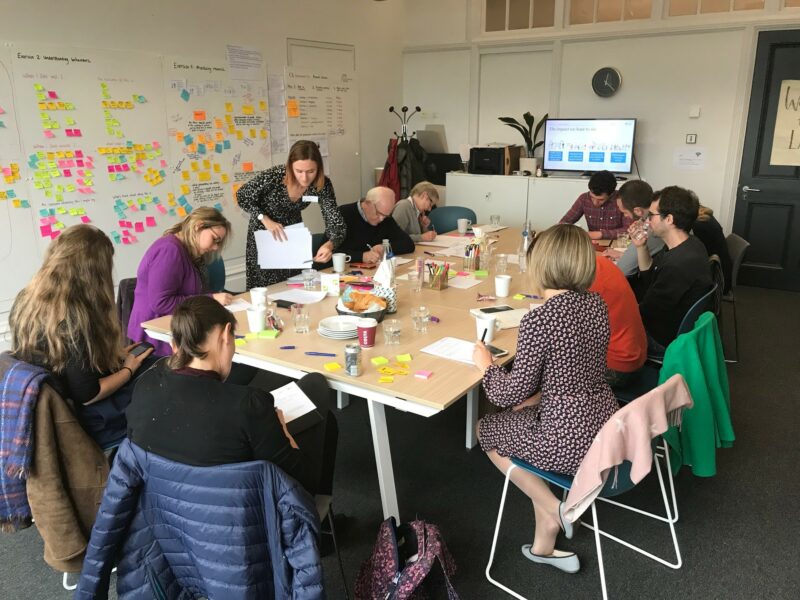Two months ago the Q Lab launched its second project in partnership with Mind – the mental health charity, focusing on how care can be designed to best meet the health and wellbeing needs of people living with both mental health problems and persistent back and neck pain.
As my colleague Libby discussed in her last blog, the Lab begins with understanding the problem deeply from a range of perspectives; drawing on the data and evidence that’s available and bringing this together with people’s lived experiences of the problem.
The Lab is still in this ‘research’ phase which will last until the end of the year. Last month we shared some early insights from initial desk research and a survey that 140 people completed sharing their experiences of the problem and suggesting research and good practice.
Since then almost 90 people from across the UK have signed up to be involved in the Lab (take a look here if you’re interested in finding out more).
Insights from Lab participants
At the end of October a series of research sessions were held at the Q Lab office and online. The sessions created space for Lab participants (people with experience and/or expertise of the topic) to add to the Lab’s very early findings, and help set the strategy for upcoming work. 25 people attended the sessions that took place on consecutive days, with each session building on the last.

Across the week we heard powerful accounts of the issues people have faced in navigating the health and care system, having their conditions recognised, and the personal journeys people had been on to understand the connections between their pain and mental health.
Emerging themes on the topic
Mental health problems and back and neck pain are important issues in their own right. One in 4 people in the UK will experience a mental health problem each year and back pain affects around a third of the UK population each year (ref). Some of the symptoms of depression and pain overlap (such as difficulty sleeping, poor concentration and low energy) (ref) and there is a complicated relationship between how the conditions co-exist:
“Having already had depression or anxiety increases the risk of developing persistent pain, but if you develop a chronically painful condition without such a history, you have dramatically increased chances of being diagnosed with depression.” (ref)
We have sought to understand the impact of living with the conditions, and the biggest issues in how health care services are designed to meet their needs. A small number of themes are beginning to emerge.
How pain is understood as more than a physical symptom
There are many challenges around how pain is understood as more than a physical symptom. People described that they and their families had often been on a learning journey to understand pain, and the interconnection with mental health. The need for education on this is relevant on many levels – at the individual level for people who experience pain and mental health problems, at a wider societal level for the messages that we learn and reinforce, and at a service level, particularly with health care professionals who need to support people develop this understanding.
How the condition changes your life
Having either mental health problems or persistent back or neck pain can have an enormous impact on someone’s life. There is important learning about the different approaches that people have taken to self-management, the ‘grieving’ process that people may go through for their old life, and learning to live in a new way. An insight discussed in many sessions was how pain does not have to equal suffering; you may often experience pain but this is different from suffering when pain is unmanaged.
Key touchpoints, interactions, actors
Some important touchpoints, interactions and actors were discussed – which could lead us to useful interventions to test. As you’d imagine, there has been lots of discussion about the interactions between physical and mental health staff – with some positive examples of people finding ways to work across service boundaries to improve care. There was specific discussion around the issues in referring – around bureaucracy and differing clinical risk, understanding the services exist out of your specialty, or being comfortable discussing conditions ‘out of their usual context’ (be that a physical or mental health service).
Key points in the journey or pathway
There are some points in the journey that are emerging as important. This includes the first point of contact/ ‘diagnosis’, discussing the range of treatment options that may be helpful, and what happens when you get stuck between lots of different services, with no single service being well placed to meet your holistic needs. We are keen to explore service models and guidelines to better understand ‘what good looks like’.
What do you think of these themes – do they resonate with your work mental health and/or persistent pain?
A more detailed write-up of the research sessions is available here.
Future research activities
Throughout November and December research into the topic will continue in three main ways:
- In-depth interviews with people who have lived experience of the conditions – to validate the themes that are emerging and to deepen our understanding about the impact of the issue and what has helped
- Speaking to people who have developed interesting service models to meet the needs of people with mental health problems and pain – to understand good practice and relevant learning
- Deepening our understanding about the systemic issues that influence this problem, including through interviews and system mapping
If you have experiences to share and would like to be involved, you can find out more and get in touch.